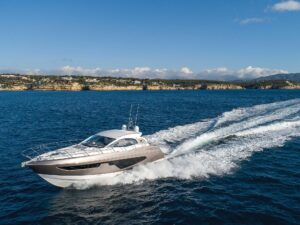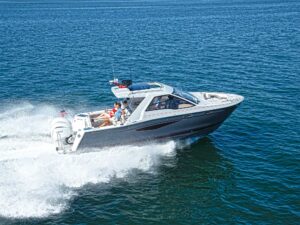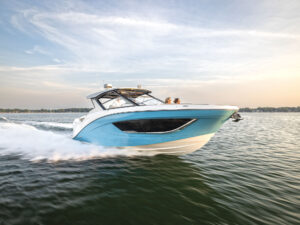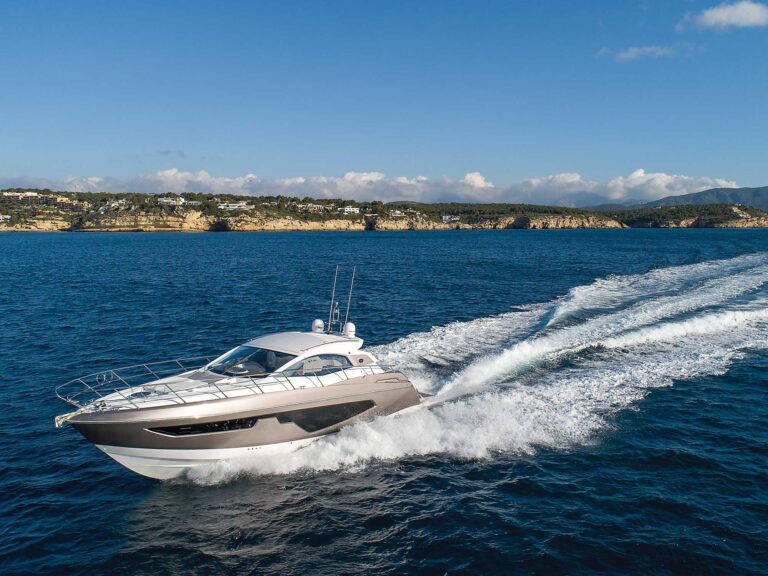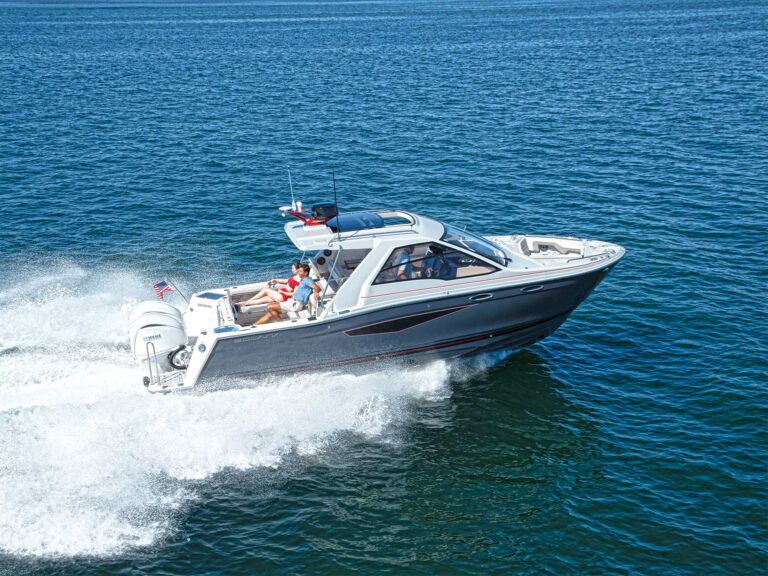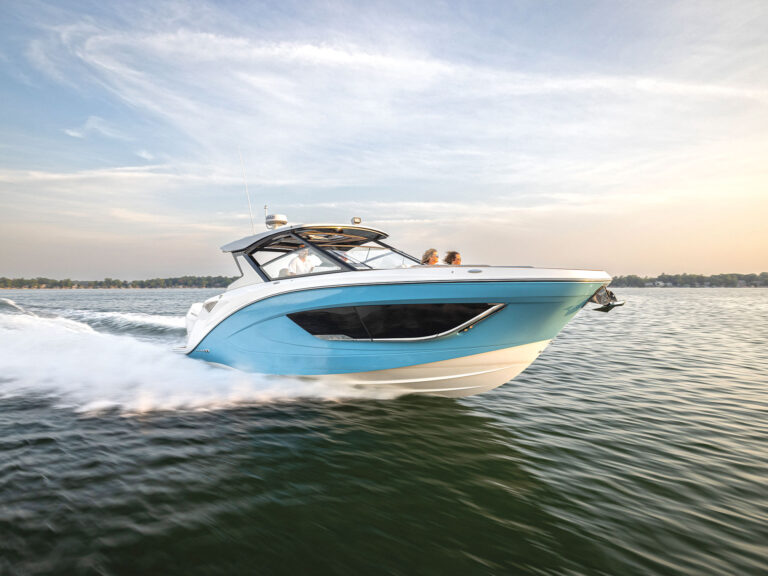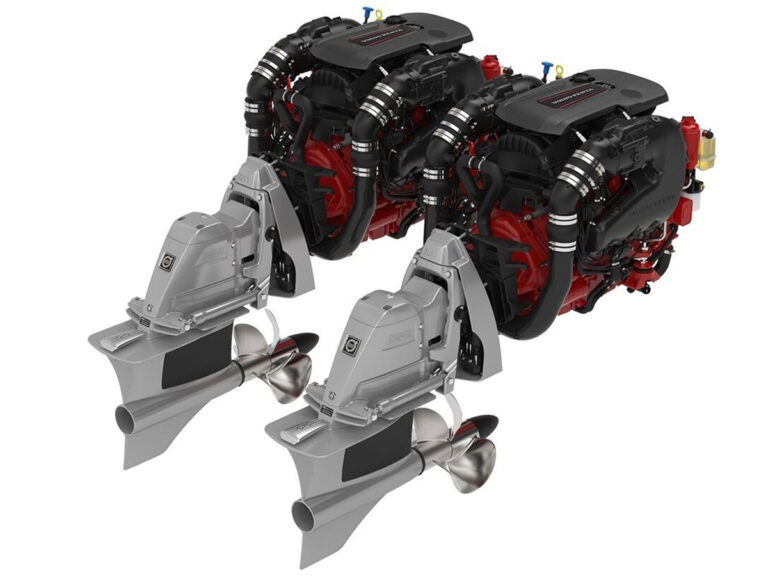It took me an hour and a half to wash down Pro-Line’s 270 Walkaround. Half that time should be plenty. What gives? You simply can’t wash down this boat without passersby stopping to comment on how good-looking it is. That’s right – the 270 Walkaround batted 1,000 in this category, whether it was after an oceanic tuna hunt or a bay day chasing stripers. People can’t just walk by this boat. They have to stop, gawk, talk, and if they’re an angler, maybe drool a little bit. This machine gives everyone boat envy.
LOOKS LIKE A FISH. Granted, the 270 Walkaround is a hot-looking boat, and I’d stop to take a gander, too. Styling details like the pipework, which curvaceously follows the lines of the windshield and cabin top, or the coaming bolsters with graphics coordinated with those found on the hullsides, jump right out at you. Of course, eye candy like this won’t help you catch more fish. However, the 270 Walkaround’s cockpit design will. Pop up the aft seat to access a recirculating, lighted livewell. With 35 gallons of capacity and the strong baitwell pump, four dozen 6″ menhaden – baits that are incredibly hard to keep alive in captivity – live up to two days in here. And if you can get a big fish to eat one of those livies, that trophy will fit into either of the dual fishboxes in the sole. Our biggest fish of the summer was a 54″ bluefin tuna in the 90-pound range, and it fit into the box without bending the tail much. Thanks to a thick coating of foam insulation on that fishbox, it also held three 20-pound bags of ice all day in 90-degree weather, while we waited for that tuna to arrive.
Other fishing features you’d expect – under-gunwale rodracks, four gunwale-mounted rodholders, coaming bolsters, spreader lights, and four rocket launchers – are all present and accounted for. In fact, we ran the 270 Walkaround through 18 offshore fishing trips and countless bay trips and found nothing to complain about. Well, almost. The one anti-fish feature is the integrated Euro transom/motor bracket, which puts the outboards far aft where they’re hard to reach around. Yes, you’re right, just about every modern outboard-powered walkaround in this class, like Pursuit’s 2870 WA ($104,360 with twin 200-hp Yamaha HPDI outboards) or Grady-White’s 282 Sailfish ($103,250 with twin 200-hp Yamaha HPDI outboards), has the same setup. And no, we never did lose a fish to the props. But it sure is a challenge trying to steer a pelagic past twin outboards with a short standup rod.
THE HIGHS: The best-looking boat in the marina. Cruise near 40 mph in good weather; maintain 20 mph in just about anything else. More beef and less breakage than on most similar boats.** **
THE LOWS: Washdown time is extended due to gawkers and squawkers. Integrated Euro transom puts props out of reach of standup gear. High gunwales put you out of reach of the water.
That far-aft motor placement has some advantages, though. At all speeds the 270 Walkaround is a good handler. And its dockside maneuverability is as good as outboard-powered boats get. Even with the powerplants positioned close together, it doesn’t take much throttle oomph to get the boat spinning in its own length. The motors’ far-aft positioning also helps cut down on noise, though you’ll still hear about 90 dB-A at cruise with the full enclosure up. Drop the canvas to reduce the buzz.
MUSCLE BOUND. Run a boat for an entire season, both offshore and inshore in virtually every condition possible, and you get to know it pretty well. That’s why we do long-term tests in the first place. So here’s the scoop on the 270 Walkaround: In calm seas, you can cruise comfortably between 36.9 and 42.8 mph, turning 4000 to 4500 rpm. In a tight bay chop up to two feet, you’ll leave the throttles right there. When seas go to three feet, plan on slacking back to 30 mph for comfort. You can maintain 25 mph in just about anything a bay chop can dish out. Running in the more widely spaced offshore waves, you won’t need to slow down for anything under three feet. You can maintain 20 to 25 mph until the waves top five feet. In six- and seven-footers we should’ve stayed at the dock – you can maintain only a bumpy 16 to 18 mph or a more sedate 12 to 14 mph.
There are few monohulls that will keep up with numbers like these. Yet numbers alone don’t tell the entire story. Fact of the matter is, the limiting factor on the 270 Walkaround is the people onboard, not the strength of the boat. The hull, supported by primary-bonded, foam-cored stringers, will chop through whatever you point it at. The rest of the boat is heavy-duty enough to take a beating far beyond what your passengers can. Sure, throughout the season there was some breakage of ancillary gear: The hinge on a hatch in the cabin bent; the refrigerator door latch snapped off; the anchor locker hatch broke off (when I stepped on it); we had some spider cracking at the port sidedeck; and the strut supporting the electronics box hatch was too weak to stay open in rough seas. But after these issues were addressed, the boat held up like a rock. Major failures? Nil. Better yet, Pro-Line’s new Pro-Care warranty will take care of all these problems. If all manufacturers offered a stem-to-stern warranty program like this, the boating world would be a better place.
Now for the things that didn’t break but should have. The all-welded bowrail, for example. On one trip, I looked over my shoulder to see my 210-pound crewman standing on the rail as he reached up to the hardtop to adjust an antenna mount. After slowing my heart rate back to normal, I surveyed the rail and found it intact, the stanchion still securely bolted to the sidedeck. Most would have bent or buckled. Next, consider the washdown spigot. While bailing next to a board at Poor Man’s Canyon, off Ocean City, Maryland, an angler on the boat hooked and swung aboard a 15-pound dolphin, still incredibly green. Its body became trapped between the cooler and the spigot, which it whacked over and over again while attempting to swim through the side of the boat at the speed of light. Lesser hardware would have broken off. Same goes for the under-gunwale rodrack insert, which took the brunt of a sliding cooler attack (120 quarts with 60 to 70 pounds of fish inside) when one of my bungee cords broke. The flimsy plastic found on so many modern fishboats would have been smashed.
FISHIN’ FAMILY. Despite the fishy attitude, the 270 Walkaround does function well when the entire family comes aboard. Or two families, for that matter. Several times when taking out friends, we had four children and four adults aboard the boat, dinner cruising, picnicking, and swimming. It was always comfortable and safe, especially considering the high gunwales (2’6″ minimum interior) and the deep walkaround. That deep walkaround, which catches you just below the knee with the rail coming up to thigh height, came in handy at other times, too. When chasing a fish around the boat, I found it the easiest to use of any walkaround-style boat I’ve ever been on, and for the first time ever I was able to walk 360 degrees around the boat without ever letting go of the reel crank to get a handhold.
The deep cockpit gunwales gave me peace of mind when the kids were aboard, but they did make for a long reach to the water. You’ll need to use the transom rigging station sink for hand washing, unless you can stretch as far as Shaquille O’Neal. You’ll need to keep your hands clean, too. Don’t forget, you got fair warning here: Run a Pro-Line 270 Walkaround and everyone will be watching you. Well, not really – it’s the boat they can’t keep their eyes off of.
Second Opinion. Having run and fished this boat in conditions ranging from a hammering three-to-four-foot bay chop to seven-foot rollers in blue water, the 270 Walkaround impressed me three ways: good looks, stability, and comfort. The good looks part you can see for yourself. Stability awareness came on the water, as the 270 Walkaround knifed through waves, holding course even in beam seas. And on long runs, there were minimal rattles and vibrations and no flex in the sole; in fact, this is one of the most solid-feeling boats in its class. What’s more, the twin Optimax outboards left other boats eating our wake, ensuring we’d be among the first to reach the fishing grounds. At the same time, their frugal fuel consumption at 30 mph and the 270 Walkaround’s 200-gallon fuel tank provided us with plenty of range.
Planning to take a big crew on your expeditions? Not a problem with the 270 Walkaround’s wide and roomy cockpit. We routinely ventured offshore with five or even six anglers aboard and “cramped” never entered our vocabulary. But I developed a love-hate relationship with the livewell, located under the aft bench seat. I loved its large capacity and powerful pump, which allowed us to carry lots of live mullet and menhaden on several trips. Its central location makes it easy to dip out and rig baits. However, this location also forces the angler to stand an extra foot or two forward of the transom, making it difficult to get your rod tip past the outboards while maneuvering large fish around the boat. My other gripe with the 270 Walkaround is the small diameter of the drain holes on the scupper grates, which clogged easily when fish scales hit the deck and had to be cleared by hand.
Aside from these two complaints, the 270 Walkaround pleased me in just about every way. If you need a fishboat that looks and rides great and can handle serious duty on offshore grounds, look no further.
LAST WORD. The 270 Walkaround proved itself in hardcore fishing and heavy seas. You don’t even have to leave the dock to get attention.
LOA…………..29’1″
Beam…………9’10”
Draft…………2’6″
Displacement (lbs., approx.) ……….6,300 ** **
Transom deadrise..19°
Bridge clearance ..9’8″
Minimum cockpit depth…………2’6″
Max. cabin headroom………6’2″
Fuel capacity (gal.)……….200 ** **
Water capacity (gal.)……….30 ** **
Price (w/standard power) ……….$82,139
Price (w/test power) ………. $97,706
STANDARD POWER: Twin 200-hp carbureted Mercury V-6 outboards.
OPTIONAL POWER: Twin outboards to 500 hp total.
TEST BOAT POWER: Twin 225-hp Mercury Optimax V-6 outboards with 185 cid, 3.60″ bore x 3.00″ stroke, swinging 21″ x 14 3/4″ three-bladed ss props through 1.75:1 reductions.
STANDARD EQUIPMENT (major items): Raw-water washdown; 35-gal. livewell; rigging station w/sink and cutting board; 8 under-gunwale rodracks; 4 gunwale-mounted rodholders; swim ladder; locking electronics box; galley w/sink, icebox, and butane stove; head w/standup shower; 2 insulated fishboxes; 3-drawer integrated tacklebox; trim tabs; all-welded bowrail; integrated bow pulpit w/anchor roller; coaming bolsters.

